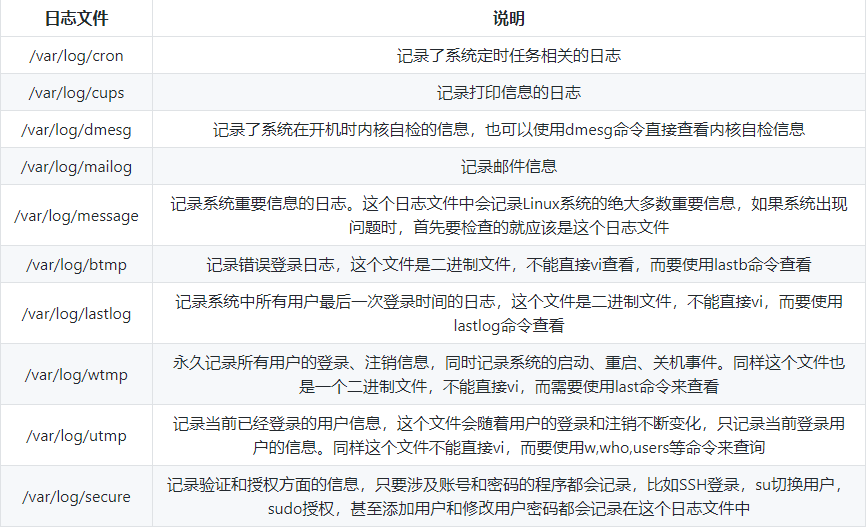A、日志分析
1、除root之外,是否还有其它特权用户(uid 为0)
awk -F: '$3==0{print $1}' /etc/passwd2、可以远程登录的帐号信息
awk '/\$1|\$6/{print $1}' /etc/shadow3、查看登录失败信息
grep -o "Failed password" /var/log/secure|uniq -c4、输出登录爆破的第一行和最后一行,确认爆破时间范围
grep "Failed password" /var/log/secure|head -1
grep "Failed password" /var/log/secure|tail -15、进一步定位有哪些IP在爆破?
grep "Failed password" /var/log/secure|grep -E -o
"(25[0-5]|2[0-4][0-9]|[01]?[0-9][0-9]?)\.
(25[0-5]|2[0-4][0-9]|[01]?[0-9][0-9]?)\.
(25[0-5]|2[0-4][0-9]|[01]?[0-9][0-9]?)\.
(25[0-5]|2[0-4][0-9]|[01]?[0-9][0-9]?)"
|uniq -c | sort -nr
6、爆破用户名字典都有哪些?
grep "Failed password" /var/log/secure|perl -e 'while($_=<>){ /for(.*?) from/; print "$1\n";}'|uniq -c|sort -nr7、登录成功的日期、用户名、IP
grep "Accepted " /var/log/secure | awk '{print $1,$2,$3,$9,$11}' 8、统计一下登录成功的IP有哪些
grep "Accepted " /var/log/secure | awk '{print $11}' | sort | uniq -c | sort -nr | more9、除root帐号外,其他帐号是否存在sudo权限。如非管理需要,普通帐号应删除sudo权限
more /etc/sudoers | grep -v "^#\|^$" | grep "ALL=(ALL)"10、禁用或删除多余及可疑的帐号
usermod -L user 禁用帐号,帐号无法登录,/etc/shadow第二栏为!开头
userdel user 删除user用户
userdel -r user 将删除user用户,并且将/home目录下的user目录一并删除11、增加一个用户kali日志
grep "useradd" /var/log/secure 12、删除用户kali日志
grep "userdel" /var/log/secure13、sudo授权执行
查看谁有sudo授权执行权限(权限级别)
sudo -l14、服务器日志
/var/log/httpd/
/www/wwwroot/15、基础信息查看
who 查看当前登录用户(tty本地登陆 pts远程登录)
w 查看系统信息,想知道某一时刻用户的行为
uptime 查看登陆多久、多少用户,负载B、历史命令查询
通过.bash_history查看帐号执行过的系统命令
1、root的历史命令
histroy2、打开/home各帐号目录下的.bash_history,查看普通帐号的历史命令
为历史的命令增加登录的IP地址、执行命令时间等信息:
1)保存1万条命令
sed -i 's/^HISTSIZE=1000/HISTSIZE=10000/g' /etc/profile
2)在/etc/profile的文件尾部添加如下行数配置信息:
######jiagu history xianshi#########
USER_IP=`who -u am i 2>/dev/null | awk '{print $NF}' | sed -e 's/[()]//g'`
if [ "$USER_IP" = "" ]
then
USER_IP=`hostname`
fi
export HISTTIMEFORMAT="%F %T $USER_IP `whoami` "
shopt -s histappend
export PROMPT_COMMAND="history -a"
######### jiagu history xianshi ##########
3)source /etc/profile让配置生效
生成效果: 1 2018-07-10 19:45:39 192.168.204.1 root source /etc/profile3、历史操作命令清除
history -c
但此命令并不会清除保存在文件中的记录,因此需要手动删除.bash_profile文件中的记录。4、入侵排查:
进入用户目录下cat .bash_history >> history.txtC、检查异常端口
1、使用netstat 网络连接命令,分析可疑端口、IP、PID
netstat -antlp|more
!net
lsof -i:80 查看指定端口
netstat -anp|grep 158.x.x.x 从连接的IP来定位PID,如果是瞬时建立的才找不到
2、查看下pid所对应的进程文件路径
运行
ls -l /proc/$PID/exe
file /proc/$PID/exe($PID 为对应的pid 号)D、检查异常进程
使用ps命令,分析进程
ps aux | grep pid (pid表示要查询的关键字)F、定时任务
1、查看定时任务
crontab -l 表面上查看定时任务
cat /etc/crontab 查看定时任务的文件里面是否存在定时任务
ls -al /var/spool/cron/\*
cat /var/spool/cron/\* 查看文件夹里面是否有其他定时任务的文件
ls -al /etc/cron.d/\*
for u in \`cat /etc/passwd |cut -d ":" -f1\`;do crontab -l -u $u; done2、删除定时任务
crontab -r 表面上删除定时任务2、编辑定时任务
crontab -e
定时任务解读:
前面5个星分别代表分-时-天-月-星期 后面跟命令
\* \* \* \* \* command
\*/15 \* \* \* \* command(表示每15分钟运行一次)
F、杂项
查看ssh秘钥
cat .ssh/authorized_keys 查看命令
/root/.ssh/authorized_keys ssh秘钥文件所在路径查看CPU运行
top结束进程
kill PID
kill -9 PID 彻底杀死进程
kill -KILL PID 强制杀死进程查看进程
ps -a 列出的是当前控制终端启动的进程
ps -A 系统全部启动进程
ps auxf 查看父进程关联的子进程
pstree 查看进程树开机启动的一些路径
/etc/rc.d/rc
/etc/rc
/etc/rc.local
/etc/rc.d/rc.local
/etc/rc.d/rc
/etc/rc$runlevel.d/ 该目录下都是链接的可执行文件,也可以自己添加可执行程序
/etc/ld.so.cache
/etc/ld.so.preload
/usr/local/lib/libioset.so
/etc/init.d
另外一个添加启动项的地方在 /etc/profile里面,还有 /etc/profile.d/目录下以sh结尾的文件封禁IP
参数-I是表示Insert(添加),-D表示Delete(删除)。后面跟的是规则,INPUT表示入站,1.1.1.1表示要封停的IP,DROP表示放弃连接。iptables -I INPUT -s 1.1.1.1 -j DROP 封禁IP进口
iptables -I OUTPUT -s 1.1.1.1/24 -j DROP 封禁IP出口
iptables -I INPUT -s 1.1.1.1/24 -j DROP 封禁IP段
iptables --list 查看规则yum install iptables-services
chkconfig iptables on
service iptables save
cat /etc/sysconfig/iptables
service iptables start
iptables -nL查看系统服务
如果删除了计划任务,还有文件删除不了 可以查看系统服务是否存在病毒
chkconfig –list #列出所有的系统服务
chkconfig –add httpd #增加httpd服务
chkconfig –del httpd #删除httpd服务文件下载
如果关闭了FTP,又无法使用xftp访问卡原始用scp命令下载scp -r 目标文件路径 [email protected]:/home/查看运行文件所在路径
ll /proc/PID 查看程序对应的启动位置
which XXXX 查看程序在哪个文件夹 XXXX表示程序名
lsof /usr/bin/\* 查看某个路径下的运行中的进程列表
pidof /usr/bin/\* 查看某个路径下运行进程的 pid对文件进行限制
chmod 000 /usr/bin/XXXXXX 设置一个文件权限为空(就是什么权限都没有
chattr +i /usr/bin 限制对/usr/bin路径修改
chattr -i /usr/bin 开放对/usr/bin路径修改
工具篇
1、Rootkit查杀
chkrootkit 网址:http://www.chkrootkit.org使用方法:
wget ftp://ftp.pangeia.com.br/pub/seg/pac/chkrootkit.tar.gz
tar zxvf chkrootkit.tar.gz
cd chkrootkit-0.52
make sense
#编译完成没有报错的话执行检查
./chkrootkit使用方法:
wget https://jaist.dl.sourceforge.net/project/rkhunter/rkhunter/1.4.6/rkhunter-1.4.6.tar.gz
tar xzvf rkhunter
cd rkhunter
./installer.sh --layout /usr --install
rkhunter --update
rkhunter -C2、病毒查杀
ClamAV的官方下载地址为:http://www.clamav.net/download.html

